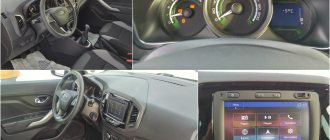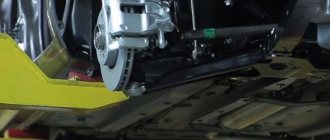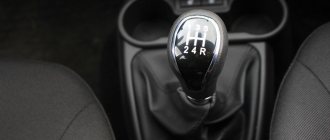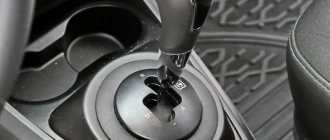After the start of production of Lada cars, when the AMT robot took its place in their configuration, a lot of reviews accumulated about the advantages and disadvantages of this transmission.
The review of reviews is general and not personalized and will sometimes be presented in comparison with either a conventional manual or also a conventional, but automatic transmission.
For beginners, let us inform you that the AMT robot is a gearbox with robotic elements based on the principle of a manual transmission, but with the addition of a device that provides automatic gear shifting. Looking ahead, the advantages of the transmission are associated with the definition of “low” - low consumption, low cost. The only downside is that gear changes sometimes result in a loss of traction.
General information about the AMT robot
- The mechanical part is based on a five-speed modification of the VAZ model 2180 gearbox. Moreover, this gearbox is equipped with gear pairs with different output ratios for different Lada models. For example, the Vesta box has this output indicator of 3.9, when, as on Grants and Kalinas, it is 3.7.
- You cannot take an actuator (clutch pressing mechanism) and robot electronics and put it on a regular box of the same VAZ 2180 model so that the result is a robot. Although the reverse procedure of replacing a robot with a mechanical one can be carried out with overcoming some obstacles.
- It is believed that the actuator cannot be repaired or maintained, but this is not for our craftsmen. Cases of its failure, judging by the reviews, are very rare. Usually, they happened at the beginning of operation, while still under warranty. There were no cases of refusal to replace.
- The recommendation to change the oil in the AMT at a mileage of 120 thousand does not stand up to the criticism of mechanics; they recommend doing this at 75 thousand mileage.
- The adaptability or adaptability of the transmission to changing operating conditions of the engine and its load, the position of the gearbox engaged mode sensors (ECP), as well as the gas and brake pedals is ensured by reading the sensor information and analyzing this information. And based on the algorithms embedded in the robot’s program, a certain order of its actions is formed. In this case, the driver’s actions in various situations are taken into account, which are stored in the robot’s long-term memory. If we say all this in a simple and understandable language for everyone, then the AMT transmission adapts to the characteristics of the driving style of a particular driver and road conditions. Moreover, for this she usually needs a couple of tens of kilometers of driving in the city.
- The AMT robot is sensitive to engine load and quickly responds to the activation of maximum torque. At the same time, each subsequent gear can be engaged only when the engine speed drops below 2.5 thousand, and each subsequent one when the range from 4 to 4.5 thousand revolutions is reached. In addition, the degree of load perceived by the engine is taken into account. For example, on a slope, the AMT robot will switch to a lower gear if the load on the engine decreases, but will leave it in the most economical operating mode.
- AMT has its own peculiarities of operation in accordance with the established transmission modes. For example, in “M” mode, the gearbox switches faster compared to “A” mode.
[ads1]
Robotic gearbox
For strategic reasons of AvtoVAZ, the Lada X-Ray was equipped with an AMT instead of an automatic transmission. The first reaction of car enthusiasts in this regard was negative, but later in practice the robot proved its worth and met the expectations of management, earning trust and an excellent reputation among car owners. The Lada Xray is equipped with a Russian-made robot, which was able to surpass its foreign counterparts in quality.
The robotic transmission found on the Lada Xray has electronic components built into it that compensate for the clutch. German actuators are installed in the new box, and the clutch is manufactured by VALEO, a world-famous company. The robot operates in “automatic” and “manual” modes.
Characteristic features of the robot installed on X-Rey:
- there is protection against incorrect switching;
- availability of automatic/manual modes;
- Xray with such a transmission allows for fast acceleration;
- there is a gear reset mode;
- low fuel consumption (about 6.5 liters in the city);
- low oil consumption;
- does not require warming up even at very low temperatures, you can immediately turn it on and go;
- the automatic transmission installed on the Xray independently adapts to the driver’s driving style, while normalizing fuel consumption and increasing ride comfort;
- the robot lever on the Xray does not create vibrations, the box operates silently;
- thanks to the robot, the Lada Xray can tow other cars and transport trailers;
- Automatic gears shift quickly, without jerking or various twitches.
Features of operation
In accordance with the reviews, a list of custom features of the AMT transmission has been compiled:
- Unlike an automatic transmission, AMT does not have such a mode as “parking” or “P”. Therefore, reviews recommend leaving the AMT in gear when parked, turning off the engine in mode “A” or “R”. And with the engine not running, move the lever to “N” mode, but even in this mode the gear will be engaged. When the ignition is turned on, the speed will automatically turn off. Therefore, you need to remember this feature of the AMT, and to prevent the car from rolling, in this case the car is fixed with the brake pedal. Moreover, the car will not start without pressing the brake pedal. Which some car enthusiasts point out as a disadvantage, and others as an advantage that increases the safety of starting the engine when the speed is accidentally turned on, for example, as with a manual transmission;
- Unlike simple mechanics and an automatic transmission, AMT will not move the car at idle speed, that is, driving at idle speed is impossible. To start moving smoothly, you need to add engine speed by pressing the gas. What is indicated as a disadvantage in reviews from residents of megacities, who often find themselves stuck in traffic jams. Therefore, for those who periodically encounter traffic jams, during short stops it is recommended to switch the lever to the “N” mode, because after a minute of parking with the brake pedal not pressed, the switch will disconnect the clutch by pressing the release lever, which can subsequently negatively affect the release bearing . However, some reviews provide examples of the opposite opinion, that this has absolutely no effect on the condition of the release bearing;
- There are many opinions in the reviews about braking using AMT. When braking the engine by resetting its speed, the AMT reacts quite sensitively in higher gears by switching to lower ones, but many recommend doing this in combination with the brake pedal depressed. Regarding smooth braking with the help of brakes, AMT “helps” to brake by switching lower gears. But during heavy braking, the AMT completely disengages the clutch. But in some reviews there are stories about some “sagging” of the brake pedal in these cases.
- after sharp braking, the clutch remains open until the engine speed is increased by the gas pedal;
- When you apply emergency braking using the brake pedal, the Brake Assist System (BAS) is activated and the clutch is instantly released.
Motorists' reaction
Initially, many were skeptical, believing that a robotic gearbox would not replace the classic automatic transmission. However, with use, all the advantages of the transmission came to light, and the absence of breakdowns added points to the AMT’s treasury. However, many believe that without a full-fledged automatic transmission, the Lada X-Ray will still be difficult to compete with other models.
The presented video briefly describes the technical data of the Lada X-Rey. The AMT box is also mentioned:
Features of running in with a robot
In the reviews, especially from those who recently got behind the wheel of a Lada with an AMT robot, there is a lot of talk about how the robot is supposedly “dumb.” But there is a simple explanation for this supposedly “freezing” AMT. In the process of getting used to a new car, any driver, even impudent in other cases in relation to cars, does not “fall”, so to speak, with all his weight on the gas pedal.
He tries to drive the car like a pensioner, driving at low and medium speeds. Moreover, if, according to the AMT gear shift conditions, each subsequent gear is engaged when the engine reaches 4.5 thousand revolutions, then in this case this driver will not wait for the AMT to engage an upshift. This is the whole reason for the “stupidity” of AMT. In response to such statements, one can suggest that such drivers first “use” their brains, and then give the car gas. And immediately everything will fall into place.
[ads2]
Lada Xray – automatic transmission or AMT?
The solution to this issue was extremely important for the company, because the domestic manufacturer intended to create a modern, technologically advanced and relatively inexpensive car. It was for budgetary reasons that the hatchback option with a classic 5-speed automatic transmission was discarded, as this would have significantly affected the price of the Lada X-Ray. Of course, there was the option of equipping it with a 4-speed torque converter from the Japanese concern Jatco, but installing just a 4-speed gearbox was considered pointless, since with it the image of the model as a technologically advanced car would immediately fade.
Robotic box AMT Lada X-Ray. As it turns out, this is the golden mean between price, quality and convenience.
As a result, a compromise solution was found - a 5-band, robotic transmission of the AMT type of the VAZ-21827 series.
Features of the “behavior” of the robot after running in
As a rule, after running-in, the robot and the driver adapt to each other. The driver already automatically starts the engine from the neutral position of the lever and simultaneously presses the brakes. Gear changes have returned to normal and become shifts without interruption in the power flow or without “jerking”.
Some reviews regarding the “behavior” of the robot after running-in recommend not to “fall” on the gas pedal when starting to move, trying to quickly gain speed to switch from the initial speed to the next one. This manipulation does not give the desired effect, however, the transition from second gear to third and subsequent transitions will be carried out much faster, unless, of course, you reduce engine speed by releasing the gas pedal.
In traffic, it is recommended to accelerate within the appropriate gear for the traffic flow, which makes driving as economical as possible. In this case, the gas pedal can be used to control the robot, indicating the engine speed at which switches it needs to make.
Details about the work of the “robot”
Let me make a reservation right away - not mine... This is exactly a test of boxes. But I decided to add it to the review precisely because for the first time I came across a detailed description of all the operating algorithms and features of the “robot” - and since it was written by a pro, it was much better than I could have done it. I would like to note that this all coincides 100% with my personal impressions, and I commented on a couple of points there (in parentheses)
"Robot" for all occasions
There is an opinion among people that the number of pedals for a driver determines not only his driving skill, but also emphasizes his behavior on the road. An active driver will sacrifice a little comfort and choose “honest” mechanics. A leisurely pilot will rely on comfort and give preference to a robotic transmission. We checked what can be expected from both types of gearboxes during a test drive of new Russian crossovers. For an honest analysis, two LADA XRAYs with maximum configuration were taken for testing. The only differences between them are the engines and gearboxes. The equipment is identical and does not affect the results of the study. The conditions for testing each sample are also the same - two weeks with each sample. The testing place is the jungle of megacities.
We were the first to roll out a crossover with a 1.8-liter engine with a power of 122 hp to the conditional testing ground. and a robotic gearbox. We deliberately program ourselves for a leisurely driving style and set off to drive around the city streets. When you lightly press the gas pedal, the two-pedal crossover behaves confidently. It shifts to a higher speed at 2500 rpm. In this mode, a minimum amount of fuel is consumed and the car quietly accelerates from intersection to intersection. Here you can even achieve that in fifth gear the car moves at a speed of 60 km/h. More active movement can be achieved by pressing halfway on the gas. With this pedal position, switching occurs already at 3500 rpm. This mode is more comparable to measured behavior on the road, when the driver follows the popular rule - to drive at the speed of the main stream. It is better not to stay in the right lane here, because you will have to constantly change lanes when overtaking and resort to active taxiing. The 122-horsepower engine has enough power to overtake without even slowing down. At the same time, no strong “pecks” are noticeable in the car’s behavior, and the process itself takes approximately the same time as when changing gear with a “manual” gearbox.
During the first kilometers we study the behavior of the automation and study its leashes. Suddenly I remember the parting words of project director Oleg Grunenkov that creating “harmony” with the “robot” is possible only after some time, when the computer itself determines your preferences in control. 28 modes adapt to different drivers - from a “turtle” walk in the right lane to a hare sprint between cars. By the way, the new engine with AMT does the latter quite well. If the driver presses the gas pedal to the floor, then within a few seconds the car drops the gearbox down several gears, increases the speed to maximum and quickly rushes into the distance.
You can spin any gear only up to 5500 rpm. According to the developers, there is simply no reason to spin the engine any further. And there’s no point in “tormenting” the engine further if the maximum torque of 170 Nm is achieved at 3750 rpm. In this mode, LADA XRAY has an interesting feature. If instant acceleration is needed at speeds above 70 km/h, then the automatic system first makes a powerful throttle change and only then goes down several steps. A kind of signal for the driver: “I’m ready. Maximum acceleration will begin now!” As for the test at high speeds, here XRAY also did not fall flat on its face. If the speedometer shows about 135 km/h, and the pressure on the gas does not weaken, then the car will hold 4th gear until the maximum speed. So somewhere on the autobahn our LADA will easily maintain 160 km/h in fifth gear at medium speeds. In general, we are satisfied with the performance of the tandem of the 1.8 liter engine and the “robot”. The only thing it lacks is the ability to start moving when you release the brake pedal. In traffic jams, constantly switching your foot from the brake to the gas is neither convenient nor safe. (well, by the way, then it’s generally “scary to drive” in a traffic jam ;-)) It’s much more practical to keep it pressed and, if necessary, release it slightly for a little progress.
Choosing mechanics has its pros and cons. One of the obvious shortcomings is the extra pedal in the foot area. Fewer and fewer driving school graduates are expressing a desire to work with it, preferring to trust their lives to “automation.” But adherents of the “honest” box have something to be proud of. After all, only they are capable of 100% control of their car, preventing interference from the virtual system. You don't have to look far for examples. LADA XRAY is “on a stick” and wedges into the flow from a secondary road faster, and can safely reduce the distance to its neighbor in the flow. AMT is far from such acrobatics. Everything is logical: owning a manual transmission is the ability to control the car in a filigree manner. But here, too, electronics will take on some of the responsibilities.
In our case, this is the role of a hint. If, according to the system, the revolutions on the tachometer do not correspond to the set gear and speed, then the indicators on the dashboard may light up. These are two icons in the form of a schematic image of a gear knob with up and down arrows. The algorithm is very simple: speed is too low - shift to a lower gear. As you accelerate, try to upshift more often. For example, in fuel saving mode, the system will advise you to “throw” the gearbox higher already at 2500 rpm. A more dynamic movement is determined by the transition to a higher stage already at 3500 rpm. The most driving mode, when you have the gas to the floor, allows you to bring the rpm needle up to 6000. Then the engine simply goes to the cutoff and doesn’t spin anymore.
The Japanese 16-valve unit is good only at medium speeds, because its maximum torque is less - 150 Nm at 4000 rpm. Weaker in power than the 1.8 liter by 12 hp. it is perfect for the French five-step. 1.6 and 110 l. it’s more than enough during overtaking on the highway and during “fun” starts from traffic light to traffic light. But alas, AVTOVAZ recently announced that it would stop assembling the XRAY with such a unit. Instead there will be a Russian 1.6 liter with 106 hp. It can be turned more, and it is much more profitable to maintain than a Japanese unit. If we recall the winter control mode, here the MT clearly outperforms the AMT, although the latter can also slow down the car at speeds. It is enough to switch the selector to manual mode and up to 2nd gear you can force the car to reduce speed using the revolutions rather than the brakes.
In terms of fuel consumption, manual transmission has virtually no advantage. Fuel consumption on both boxes is the same and during break-in it costs 10 liters in the combined cycle. The only place where the owner of a manual transmission saves is in the moments of transition to quiet mode after acceleration mode. The manual transmission switches to a higher gear after overtaking instantly, while the AMT still stalls for almost a minute until it realizes that it’s time to slow down to normal and return to a calm pace. (The guys simply didn’t realize that by releasing slightly and then pressing the gas pedal, you can force the AMT to switch immediately; on a manual, you still have to squeeze the clutch.)
Honest French mechanics are good and fully realize the capabilities of the 1.6 liter engine. But the future lies with automated transmissions. Cars are increasingly becoming gadgets, and as we know, the smarter they are, the better. At AVTOVAZ they taught AMT to drive correctly, but they did it only for the 1.8 liter engine. In the version with 1.6 l. The automated transmission is rather weak. So in the battle between robot and mechanics, we honestly give victory to the two-pedal version. Its settings very accurately reflect the behavior of different drivers, implementing it in the car software.
Source: LADA Xray Club
https://www.ladaxray.net/test-drive/327-bitva-korobok-lada-xray-16-l-na-mehanike-vs-18-ls-amt.html#
Features of the future “behavior” of the robot
At the beginning of 2022, VAZ conducted surveys of users of cars with an AMT robot, probably noticing that many complaints were coming from car owners living in megacities, who are under the threat of regularly getting stuck in traffic jams, where the gearbox shows not entirely favorable “behavior.” And all this is due to the lack of the so-called “creeping mode”.
If we consider the conditions of being stuck in traffic jams, there are only two types of traffic jams:
- The first type is a standing traffic jam, where traffic occurs in the mode: drive 5-10 meters and stop. In this mode, judging by the reviews, the gearbox robot behaves quite well: the driver pressed the gas pedal - it moved smoothly and began to move, released the gas pedal - it stopped.
- The second type of traffic jam is when the flow of traffic moves at walking speed, where the notorious “creeping mode” is required. In this case, it is difficult for the driver to select the engine speed not in the first gear of the gearbox in order to move synchronously with the flow of cars in a traffic jam, since when adding gas, the gearbox takes a pause while the car is still rolling, and then begins sharp acceleration, while the driver releases the gas pedal and clutch turns off, etc. If you look from the side, the car moves jerkily.
According to yet unconfirmed information, it is precisely this problem of the AMT’s lack of a “creeping mode” that the VAZ developers plan to solve.
Among the advantages are:
- High-quality and reliable operation of the light sensor;
- Good navigation;
- Large and roomy glove compartment;
- Accurate performance of the gearbox;
- The radio finds almost all radio points even in the most crowded village;
- High-quality audio system, the operation of the radio inspires confidence;
- The climate system works well. No condensation, foggy windows or other problems;
- In addition to the main socket in the trunk, you can find another additional one;
- The fifth door rises quite high. Even with a height of more than 175 cm, the head does not reach her.











